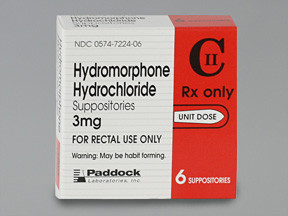HYDROMORPHONE SUPPOSITORY - RECTAL
PHONETIC PRONUNCIATION: (hye-droe-MOR-fone)
COMMON BRAND NAME(S): Dilaudid
GENERIC NAME(S): hydromorphone HCl
Uses
USES: Hydromorphone is used to treat moderate to severe pain. It acts on certain centers in the brain to give you pain relief. This medication is an opioid (narcotic) pain reliever.
How to use HYDROMORPHONE SUPPOSITORY - RECTAL
HOW TO USE: Wash your hands before and after using the suppository. Unwrap and insert one suppository into the rectum as directed by your doctor. Lie down on your left side with right knee bent. Gently push the suppository into the rectum with your finger. Remain lying down for a few minutes, and avoid having a bowel movement for an hour or longer so the drug will be absorbed. The suppository is for use in the rectum only. If you have nausea, ask your doctor or pharmacist about ways to decrease nausea (such as lying down for 1 to 2 hours with as little head movement as possible). The dosage is based on your medical condition and response to treatment. Do not increase your dose, use the medication more frequently, or use it for a longer time than prescribed. Properly stop the medication when so directed. Pain medications work best if they are used when the first signs of pain occur. If you wait until the pain has worsened, the medication may not work as well. This medication may cause withdrawal reactions, especially if it has been used regularly for a long time or in high doses. In such cases, withdrawal symptoms (such as restlessness, watery eyes, widened pupils, sweating, runny nose) may occur if you suddenly stop using this medication. To prevent withdrawal reactions, your doctor may reduce your dose gradually. Consult your doctor or pharmacist for more details, and report any withdrawal reactions right away. When this medication is used for a long time, it may not work as well. Talk with your doctor if this medication stops working well. Though it helps many people, this medication may sometimes cause addiction. This risk may be higher if you have a substance use disorder (such as overuse of or addiction to drugs/alcohol). Use this medication exactly as prescribed to lower the risk of addiction. Ask your doctor or pharmacist for more details. Tell your doctor if your pain persists or worsens.
Side Effects
Precautions
Interactions
Overdose
Images
Reviews
Warning
WARNING: Hydromorphone has a risk for abuse and addiction, which can lead to overdose and death. Hydromorphone may also cause severe, possibly fatal, breathing problems. To lower your risk, your doctor should have you use the smallest dose of hydromorphone that works, and use it for the shortest possible time. See also How to Use section for more information about addiction. The risk for severe breathing problems is higher when you start this medication and after a dose increase, or if you use the wrong dose/strength. Using this medication with alcohol or other drugs that can cause drowsiness or breathing problems may cause very serious side effects, including death. Be sure you know how to use hydromorphone and what other drugs you should avoid using with it. See also Drug Interactions section. Get medical help right away if any of these very serious side effects occur: slow/shallow breathing, unusual lightheadedness, severe drowsiness/dizziness, difficulty waking up. Keep this medicine in a safe place to prevent theft, misuse, or abuse. If someone accidentally swallows this drug, get medical help right away. Before using this medication, women of childbearing age should talk with their doctor(s) about the risks and benefits. Tell your doctor if you are pregnant or if you plan to become pregnant. During pregnancy, this medication should be used only when clearly needed. It may slightly increase the risk of birth defects if used during the first two months of pregnancy. Also, using it for a long time or in high doses near the expected delivery date may harm the unborn baby. To lessen the risk, use the smallest effective dose for the shortest possible time. Babies born to mothers who use this drug for a long time may develop severe (possibly fatal) withdrawal symptoms. Tell the doctor right away if you notice any symptoms in your newborn baby such as crying that doesn't stop, slow/shallow breathing, irritability, shaking, vomiting, diarrhea, poor feeding, or difficulty gaining weight.
Disclaimer
IMPORTANT: HOW TO USE THIS INFORMATION: This is a summary and does NOT have all possible information about this product. This information does not assure that this product is safe, effective, or appropriate for you. This information is not individual medical advice and does not substitute for the advice of your health care professional. Always ask your health care professional for complete information about this product and your specific health needs.

No Reviews Yet